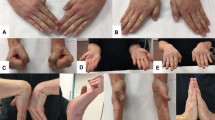Abstract
Carpal dislocations are a rare condition usually resulting from a high-energy trauma on the hyperextended hand in ulnar deviation. To the best of our knowledge, only 6 cases of bilateral volar lunate dislocation have been reported in literature, and none of them presents with an associated radial fracture. We report a 3-year follow-up of a patient who sustained bilateral volar lunate dislocation with radial fracture associated treated surgically to reduce the fracture and to reconstruct the injured ligaments. A 51-year-old sustained an injury to both wrists in a fall while paragliding. He presented with pain to both wrists and his back. Physical examination showed diffuse swelling in his wrists and tenderness to his lumbar region. A total body CT scan showed L1–L3 vertebral fractures requiring surgical treatment. Wrists radiographic investigation revealed bilateral volar lunate dislocation associated to a right wrist ulnar and radial styloid fracture with radius interposition into the scapho-luno-triquetral articulation. We treated the patient with K-wires and external fixation on the right side and K-wires and a cast on the left side. Three years after treatment the range of motion in the right wrist compared to the left was: 75°/70° of flexion, 70°/65° of extension, 30°/35° of ulnar deviation, 20°/15° of radial deviation, 85°/80° of supination and 80°/70° of pronation. Bilateral perilunate dislocations or fracture dislocations are extremely rare. These patterns of injuries are commonly missed initially, especially in patients with multiple traumas, so the patient may present at a later date with secondary complications. Perilunate carpal dislocation may be treated with closed reduction but may also require open reduction and reconstruction of injured ligaments in order to restore stability and allow return to function. The purpose of this study is to present a rare and frequently misdiagnosed clinical entity, hereupon commonly undertreated resulting in poor long-term results. Prompt diagnosis and treatment is mandatory to allow rapid return to function and to avoid secondary complications.







Similar content being viewed by others
Data availability
Not applicable.
Code availability
Not applicable.
References
Mayfield JK, Jhonson RP, Kilcoyne RK. Carpal dislocation: pathomecanics and progressive perilunar instability. J Hand Surg Am. 1980;5(3):226–41.
Mayfield JK. Mechanism of carpal injuries. Clin Orthop Rel Res. 1980;149:45–54.
Dimitriou CJ,Chalidis B, Pournaras J. Bilateral volar lunate dislocation. J Hand Surg. 2007;32E:4.
Kaneko K, Miyazaki H, Yamagichi T, Yanagihara Y, Kurosawa H. Bilateral transcapholunate dislocation. Chir Main. 2000;19:263–8.
Zoonozi E, Mazhar FN, Khazai M, Nejadgashti N. Bilateral volar lunate dislocation- a rare case report. J Res Med Sci. 2009;14(3):187–90.
Green DP, O’Brien ET. Open reduction of carpal dislocations: indication and operative techniques. J Hand Surg Am. 1978;3(2):250–65.
Spar I. Bilateral perilunate dislocations: case report with review of literature and anatomic study. J Trauma. 1978;18(1):64–5.
Fitzgerald HW. Bilateral perilunar dislocation of the carpus; report of a case. J Bone Joint Surge Br. 1950;32-B(3):386.
Bhat A, Nishanth A, Acharya A, Kumar Y. novel presentation of uncommon wrist injury: simultaneous lunate and perilunate fracture dislocation (scapho-capitate syndrome) of Both Wrists. J Orthop Case Rep Apr-Jun. 2016;6(2):50–2.
Moneim MS, Hofammann KE, Omer GE. Transcaphoid perilunate fracture-dislocation. Result of open reduction and pin fixation. Clin Orthop Relat Res. 1984;190:227–35.
Minami A, Kaneda K. Repair and/or reconstruction of scapholunate interosseous ligament in lunate and perilunate dislocations. J Hand Surg. 1993;18A:1099–106.
Mc Namara MG, Corley FG. Dislocation of the carpal scaphoid: an 8- year follow-up. J Hand Surg Am. 1992;17:494–8.
Amamilo SC, Uppal R, Samuel AW. Isolated dislocation of carpal scaphoid: a case report. J Hand Surg Br. 1985;10:385–8.
Gomez Fernandez JM, Mendez Lopez JM, GrauGaltes P, Caracuel Redondo F. Palmar scaphoid dislocation associated with dorsal perilunate dislocation. A case report and review of the literature. Rev Esp Cir Ortop Traumatol. 2013;57(2):140–4.
Adkinson JW, Chapman MW. Treatment of acute lunate and perilunate dislocations. Clin Orthop Relat Res. 1982;(164):199–207.
Sawardeker PJ, Baratz ME. Fracture- dislocation of the carpus: perilunate injury. Orthop Clin N Am. 2013;44:93–106.
Sotereanos DG, Mitsionis GJ, Giannakopoulos PN, et al. Perilunate dislocation and fracture-dislocation: a critical analysis of the volar-dorsal approach. J Hand Surg Am. 1997;22(1):49–56.
Inoue G, Kuwahata Y. Management of acute perilunate dislocations without fracture of the scaphoid. J Hand Surg. 1997;22B:647–52.
Siddiqui NA, Sarkar SP. Isolated dorsal dislocation of the lunate. Open Orthop J. 2012;6(6):531–4.
Author information
Authors and Affiliations
Contributions
All authors reviewed and approved the final version and have agreed to be accountable for all aspects of the work including any issues related to accuracy or integrity.
Corresponding author
Ethics declarations
Ethics approval
Not applicable.
Consent to participate
Written informed consent was obtained by the patient for submission to the journal.
Consent for publication
The consent for publication was obtained from the patient.
Conflict of interest
The authors declare no competing interests.
Additional information
Publisher's Note
Springer Nature remains neutral with regard to jurisdictional claims in published maps and institutional affiliations.
This article is part of the Topical Collection on Surgery
Rights and permissions
Springer Nature or its licensor (e.g. a society or other partner) holds exclusive rights to this article under a publishing agreement with the author(s) or other rightsholder(s); author self-archiving of the accepted manuscript version of this article is solely governed by the terms of such publishing agreement and applicable law.
About this article
Cite this article
Pachera, G., Tadolini, F., Briano, S. et al. Bilateral Volar Lunate Dislocation with Radial Fracture Associated: a Case Report. SN Compr. Clin. Med. 4, 243 (2022). https://doi.org/10.1007/s42399-022-01325-8
Accepted:
Published:
DOI: https://doi.org/10.1007/s42399-022-01325-8




